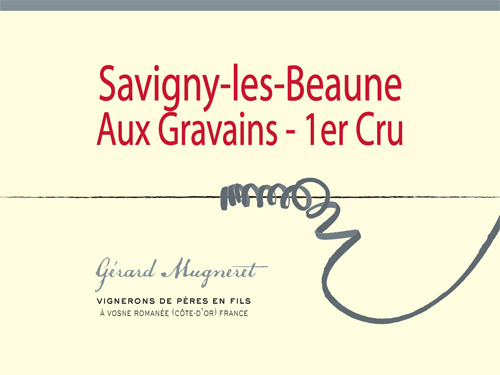Savigny-les-Beaune Aux Gravains 1er Cru
At a Glance
- Etymology: Gravains shares its etymology with Grèves and Gravières. They are derived from the latin Grava, meaning gravel, little stones, etc. (Source: Marie-Hélène Landrieu-Lussigny).
- Size: 0.29 ha (0.72 ac)
- Variety: Pinot Noir
- Vine Age: Originally planted in 1902, some replanting in 1944, and plenty of replacements. It is a venerable vineyard, with many vines suffering from the court-noué virus that keeps yields low and causes plenty of millerandage (shatter), which is very desirable for its concentration of flavor.
- Terroir: On one of our favorite hills in the Côte d’Or. It faces south and is located in the path of the of the alluvial deposits of the Rhoin river. The clays soils are consequently mixed with a high proportion of sand and rounded gravels. The name Gravains is derived from graviers, French for gravel. But there is also colluvial input of gravels and cobbles from upslope. Though the soils are fairly deep, because of the alluvial influence, they are also light.
- Viticulture: Uncertified biodynamic
- Vinification: 65% whole cluster, ambient yeast ferment. Aged in oak barrels (30% new) for 12 to 18 months. Since 2016, very moderate sulfur additions: none during vinification, a little during élevage and before bottling, for a total of 15 to 20 ppm.
Additional Info
It is noteworthy that both Pascal’s Gravains and Bruno Clair’s Dominode were planted in 1902. According to Burgundy Vintages, A History from 1845, by Allen Meadows and Doug Barzelay, 1901 was the beginning of the so-called Années Méchantes (cruel years). A cyclone hit Gevrey and did enormous damage to the vines and trees. In the Beaune area, there was a hailstorm on August 25th that also damaged some vines.
Savigny-les-Beaune has the reputation for providing wonderful value, but it is so much greater than that. As we have mentioned, Aux Gravains sits on one of our favorite hills in the Côte d’Or. Among the hill’s wonderful premiers crus, Lavières, Gravains, Serpentières and Aux Clous, form a tight-knit family on the mid-slope, with a specific identity. Their most noticeable signature comes from the influence of the alluvial sediments: sand and gravel are promotors of elegance, of lifted, airy, soft, fragrant fruit. Yet these vineyards are still in the valley, not yet on the alluvial fan. Thus, they also behave like bedrock wines and are grounded in minerality. In this case, it is discrete, even sneaky. It is a unique harmony, the result of opposite geological influences, and it is magnificent.
Wines
-
Red
- Pourpre VDF
- Bourgogne Pinot Noir
- Bourgogne Les Rouges Champs
- Vosne Romanée Quatrain
- Vosne Romanée Vigneux
- Vosne-Romanée Cuvée Précolombière
- Savigny-les-Beaune Aux Gravains 1er Cru
- Chambolle-Musigny Les Charmes 1er Cru
- Vosne-Romanée Les Suchots 1er Cru
- Vosne-Romanée Aux Brulées 1er Cru
- Nuits-Saint-Georges Aux Cras 1er Cru
- Nuits-Saint-Georges La Richemone 1er Cru
- Echezeaux Grand Cru

